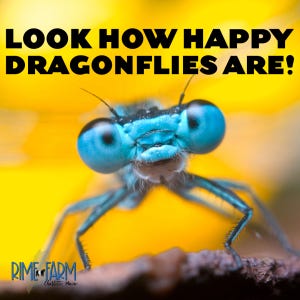Dragonflies in Maine: Nature’s Mosquito Eating Army!
Dragonflies conjur up images of fairies and toadstools–part of an ecological magic kingdom. But, did you know they are important aspects of our farm? For all Mainers, they’re a welcome reprieve from the swarms of mosquitoes that try to carry you away at dusk. Their iridescent bodies and aerial acrobats are quite something to see. Sadly, their existence is increasingly threatened by habitat destruction, pollution, and climate change. All of which pose significant challenges to their survival and the pest-eating services they provide.
Dragonflies excel in natural pest management because their diets predominantly consist of other insects. We love them because having type 0 negative blood makes me particularly susceptible to mosquito bites. And, they LOVE to eat mosquitoes! Mosquitoes in Downeast, Maine are thick and unrelenting. The notion that a non-biting insect can reduce pests naturally aligns with our sustainable farming practices. What’s more is that dragonflies act as bioindicators. In other words, dragonflies reflect the health of their habitat. High numbers of dragonflies are indicative of a well-balanced ecosystem. This makes them essential to biologists monitoring environmental quality and conservationists monitoring restorative habits or preserving critical eco-systems.
The lifecycle of a dragonfly is fascinating and complex, involving multiple stages from egg to adult.

The Egg Stage
Dragonflies lay their eggs in or near water, which at Rime Farm, include vernal pools, wetlands, and streams.
The Nymph Stage
The longest stage of a dragonfly’s life is spent underwater in the nymph form, where they are voracious predators.
The Adult Stage
The transformation from nymph to adult is a dramatic metamorphic process culminating in the dragonfly we commonly recognize with its long body, diaphanous wings and cute face!
Each stage plays a pivotal role in local food chains. Rime Farm (Zone 5b) hosts a variety of dragonfly species, such as the Common Green Darner and the Eastern Pondhawk. The University of Maine Extension has a great webpage dedicated to them. You can see it here:
Dragonflies face severe threats from habitat destruction due to development. Pollution further compounds these threats. For example, waterborne contaminants from pesticides and industrial and agricultural run-off harms the dragonfly nymphs and degrades their habitat. Climate change introduces more threat by altering water levels and the weather patterns that govern them. These combination of these ecological impacts threatens all life in the ecosystem.
This is why we find great importance habitat creation like ponds with aeration, the preservation of wetlands, and educational initiatives that raise awareness about threats and mitigation. In Maine, sustainable farming practices supports dragonflies by promoting broader ecological health and resilience against environmental disruptions.
We think dragonflies are more than just a well coordinated mosquito eating army; they’re indicators of ecological health and sustainability. Like all native species, their conservation is crucial in the face of climate change. Let’s ensure that dragonflies continue to thrive as integral parts of Maine’s natural heritage and agricultural success.
FAQs About Dragonflies
How long do dragonflies live?
While the adult dragonfly typically lives for only a few months, the entire lifecycle from egg to end of adulthood can last up to two years.
What do dragonflies eat?
Dragonflies are predators, feeding on a variety of insects like mosquitoes, flies, and sometimes even smaller dragonflies.
Can dragonflies bite or sting?
Dragonflies do not have stingers, and while they can bite if handled carelessly, they are harmless to humans.
What is the best time of year to see dragonflies at Rime Farm?
The best time to observe dragonflies at Rime Farm is during the warmer months, from late spring through early fall, when they are most active.
The post Dragonflies in Maine: Nature’s Mosquito Eating Army! appeared first on Rime Farm: Organic Farming in Downeast Maine's Changing Climate .





